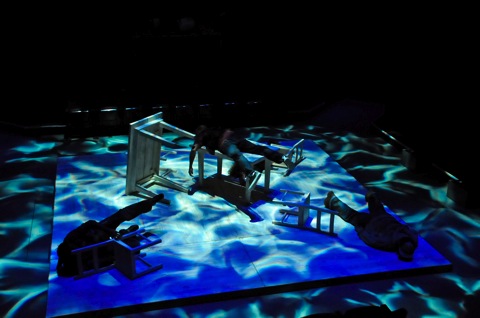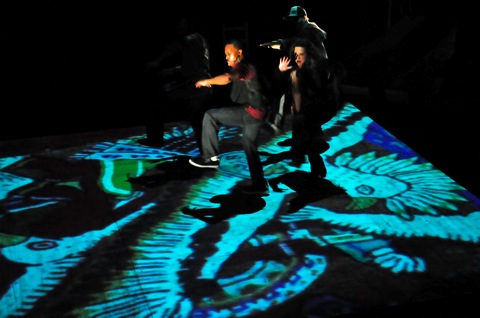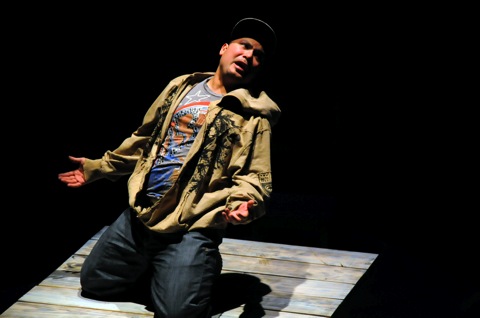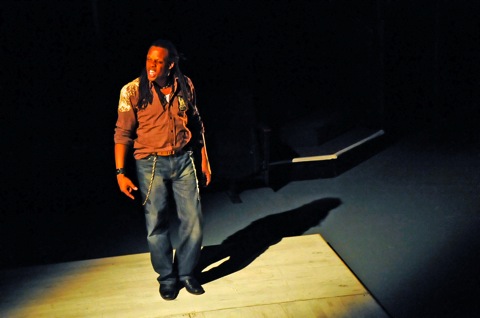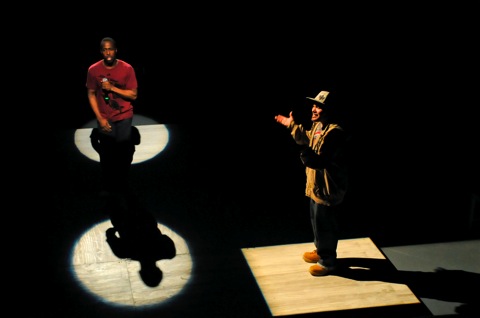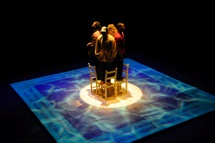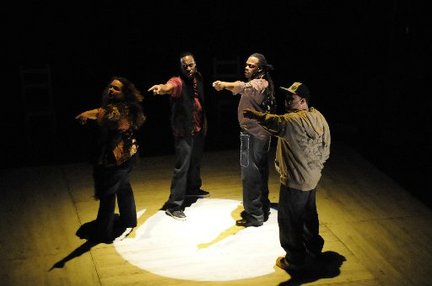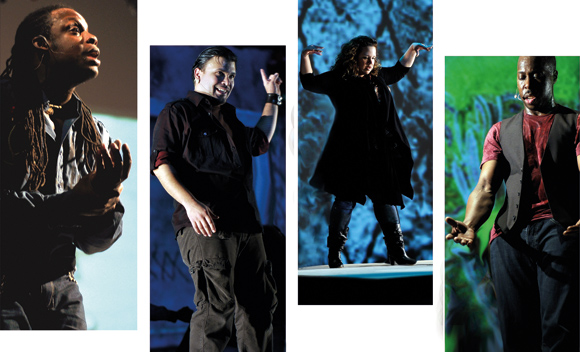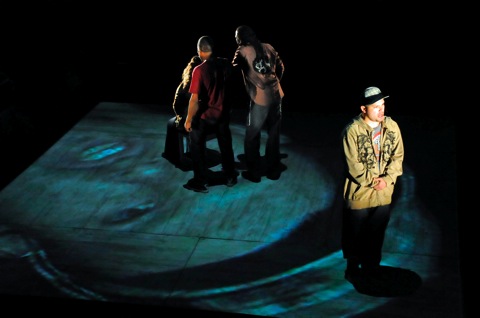- AMERIVILLE
(Steven Sapp, Mildred Ruiz, Gamal Chasten, Ninja (aka- William Ruiz)
Premiered at Actors Theatre of Louisville's Humana Festival 2009 Re-Mounted at Curious Theatre (Denver, CO) November 2009
Director: Chay Yew Choreographer: Millicent Johnnie Dramaturg: Morgan Jenness Set Design: Brian Sidney Bembridge Lighting Design: Russell Champa Sound Design: Benjamin Marcum Video Design: Brian Freeland Costume Design: UNIVERSES
Director: Chay Yew Choreographer: Millicent Johnnie Dramaturg: Morgan Jenness Set Design: Paul Owen Lighting Design: Russell Champa Sound Design: Ben Marcum Video Design: Jason Czaja Costume Design: Lorraine Venberg
http://dctheatrescene.com/2010/10/25/ameriville/
Ameriville
OCTOBER 25, 2010 BY BEN DEMERS
Moments of great strife in American history, from the Civil War, to the Great Depression, to 9/11, have wrought considerable pain, suffering, and sadness, while inspiring some of our greatest and most vital works of art. In their explosive, moving Ameriville, theater collective Universes utilizes the prism of Hurricane Katrina to explore forgotten corners of our fractured American landscape, ultimately painting a dire, yet hopeful vision of our struggling nation.
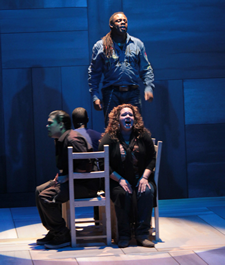
William Ruiz (A.K.A. “Ninja”), Gamal Chasten, Steven Sapp, and Mildred Ruiz (Photo: Danisha Crosby)
Now playing at Round House Theatre in Bethesda, Ameriville takes a pointed look at the current state of America through a fluid, energetic blend of spoken word, song, and dance. Each of Universes’ four members rotate through narrating duties, commenting on race relations, poverty, disaster relief, and tradition. Before sitting down to write the play, Universes lived in New Orleans, soaking up the history and culture and interviewing countless residents. As a result of their attention to detail and real investment in the lives of everyday people, their staging boasts a diverse spectrum of believable, relateable characters. Street vendors, children, tourists, barbers, hustlers, musicians, and others all come to life in Universes’ breathing portrait of a city and a nation on the mend.
The dynamic script and spirited performances reveal a polished ensemble with undeniable writing and acting skills. The play is peppered with ingenious rhymes and vivid imagery, and the foursome’s relentless energy and careful pacing transforms a series of well-written pieces into a breathless, cohesive whole that keeps the audience on the edge of their seats for the duration of the show.
Steven Sapp and Gamal Abdel Chasten inhabit a slate of memorable, complex characters, but perhaps their best moment comes during a hilarious display of rapid-fire one-upmanship. Each actor tries to prove he is “more black” than the other, lampooning widely-held stereotypes with an increasingly ridiculous string of hyperbole. Their natural talents, combined with their evident onstage rapport, make this scene a delight. William Ruiz, otherwise known as “Ninja”, proves himself quite the vocal chameleon, delivering captivating turns as a sleazy TV pitchman, a drunk Mardi Gras reveler harboring secret pain, and a child with some disturbing insights concerning human folly and cruelty throughout the ages.
The musical component of the show is equally impressive. Universes creates a variety of sonic landscapes with just their voices, conjuring R & B, gospel, traditional, and salsa numbers with pitch-perfect a cappella and skillful beat-boxing from Ninja. The group uses musical numbers primarily as beats between scenes, using the repetition of phrases to establish a particular emotion or context. For example, Universes constantly turns to verses of “How high is the water…….3 feet high and risin’…..how high is the water……..5 feet high and risin’” to remind the audience of the flooding’s terrible, inexorable assault.
Frequently, the group will mix in solos to flesh out a particular character or punctuate a scene. In a group loaded with musical talent, Mildred Ruiz-Sapp truly stands apart.With a gospel background and loads of natural ability, she sails through renditions of “House of the Rising Sun” and original solos across many styles, mixing in powerful belts and precise vocal runs to electrifying effect.
The visual design bears mention as well. Well-conceived lighting choices, abstract image and video collages, and judiciously selected projections of New Orleans aid the performers in transporting the audience into their world and eliminate the need for extensive sets that might otherwise limit Universes’ movement and versatility. In fact, the group only utilizes a simple wooden table and four chairs throughout the entire performance.
During the post-show talkback, Universes emphasized their group’s underlying goal to explore pressing social issues and to empower the audience to seek much needed change. In a cultural landscape dominated by awful reality television and the destructive 24-hour news cycle, this message has never seemed more vital. The show reminds us of the power of a small group of artists to make the audience reconsider their reality and ask “Is this good enough?”. Consider Ameriville required viewing.
Ameriville
By Universes Directed by Chay YewProduced by Universes Theater Company, Inc. Reviewed by Ben Demers

(For ATL Newsletter/Press - by: Sarah Lunnie)
How high is the water momma?
4 feet high and rising
Three years after Hurricane Katrina hit the Gulf coast, our memory betrays us. The storm drowned thousands of city residents in their bedrooms and attics, forced more than one million to flee for safety, and put 80% of New Orleans under water. But its images have receded from the covers of our morning newspapers. News of levee breaches and rooftop rescues no longer confronts us when we turn on the television. The barrage of disturbing revelations—shoddy engineering, bad science, decades of irresponsible policy converging in a lethal, man-made maelstrom—has subsided. The country has moved on. But for the displaced New Orleans residents still living in FEMA trailers or scattered across America, the storm continues.
Today the per capita murder rate in New Orleans is the highest in the nation. The Road Home Program, designed to compensate Louisiana homeowners affected by Katrina and Rita, has failed to address the state’s severe housing shortage. Many fear that rebuilding efforts will marginalize entire populations: gentrification neatly disguised as renewal. And although the Army Corps of Engineers is rebuilding the levees, most experts agree that current plans are frighteningly inadequate. In Katrina’s wake lies an interminable sea of questions, about what and whom we value and how we care for our home and each other. In an era of fast news and short attention spans, they are questions we would do well to remember.
How high is the water poppa?
8 feet high and rising
UNIVERSES (Gamal Abdel Chasten, Mildred Ruiz-Sapp, William Ruiz aka Ninja and Steven Sapp) didn’t set out to write a play about Hurricane Katrina. The ensemble’s earlier work, including Slanguage (which played at Actors in 2004) was more local in its scope, exploring the rhythms, voices and landscapes of its members’ New York neighborhoods, with a unique fusion of poetry, theatre, jazz, hip-hop, down-home blues and Spanish boleros. With Ameriville, they pan out to examine not only New Orleans, but the country at large. According to co-founder, writer and performer Steven Sapp, the project has been in the works since before the storm hit.
“After Slanguage, we started to tour a lot,” Sapp explains. “We went all around the country, and the more we saw, the bigger our new pieces became. Because what we were looking at was bigger. In the beginning, we weren’t even trying to write a new piece. Our initial thought was to look at the state that the country was in, this fear about everything. We were interested in exploring the history of fear in America. And then Katrina happened.”
The group wrote some small pieces responding to the disaster, and performed them at venues in New York City. The audience response was overwhelming. After a show at the Apollo, the group was approached by a couple that had just relocated from New Orleans. The couple told UNIVERSES they’d captured the experience of being caught in the storm in a way no one else had, and asked if any of the writers—Bronx and L.E.S. natives—were from New Orleans. It was then, Sapp says, they began to wonder if they’d found their next big project.
“That’s when Mildred suggested we tackle Katrina. And we thought, can we do that? Should we do that? We knew it had to be about more than just the storm. We knew if we were going to do this, we had to do it our way.”
How high is the water momma?
12 feet high and rising
On one level, Ameriville serves as a reminder to the rest of the nation. “We’re a selective country in terms of what we remember,” says Sapp. “Since Katrina, we’ve had forest fires in California and floods in Iowa. It’s like flipping the channel: we move on. But if you go down to New Orleans now, three years later, there are sections that look like it just happened. It’s chilling.” The play also seeks to expose deeply ingrained social inequities that existed before the levees toppled, but which came to national attention only in the storm’s wake.
The writers feel a deep connection with the people of New Orleans, built on the belief that though circumstances vary, people are the same everywhere. The title suggests that New Orleans is America in microcosm, and, by extension, that Katrina happened to all of us. Ameriville also rejects regionalism, making an argument for a more united, inclusive attitude toward citizenship. “We should be looking at each other as though this country were a village,” says Sapp. “We’re one big, giant America here. Wherever I go in this country, I’m an American when I’m there, and I should feel like one.”
UNIVERSES recently travelled to New Orleans to meet with survivors. They spoke with residents, artists, and community figureheads, and got their blessing to move forward with the project. The conversations left UNIVERSES with a feeling of great responsibility toward these people whose stories and experience are Ameriville’s core, and Katrina’s indelible legacy. Three years after landfall, as debris clears and newsprint fades, the survivors labor to repair what’s been broken; to excavate pasts from the wreckage, and rebuild their lives. Ameriville is both a monument to their struggle and a call to action for the nation: let us not forget what happened here.
How high is the water momma?
20 feet high and rising
How high is the water poppa?
24 feet high and rising
—By: Sarah Lunnie (Actor Theatre of Louisville)
AMERIVILLE was made possible by:
An Ensemble Theatre Collaborations Grant
from The Association of Performing Arts Presenters (APAP)
A creation Fund Commission
from The National Performance Network
(In collaboration with New World Theater (MA); Helena Presents (MT); and Dance Place (D.C.))
Development Lab Support from New York Theatre Workshop
The Actors Theater of Louisville
(Humana Festival)




